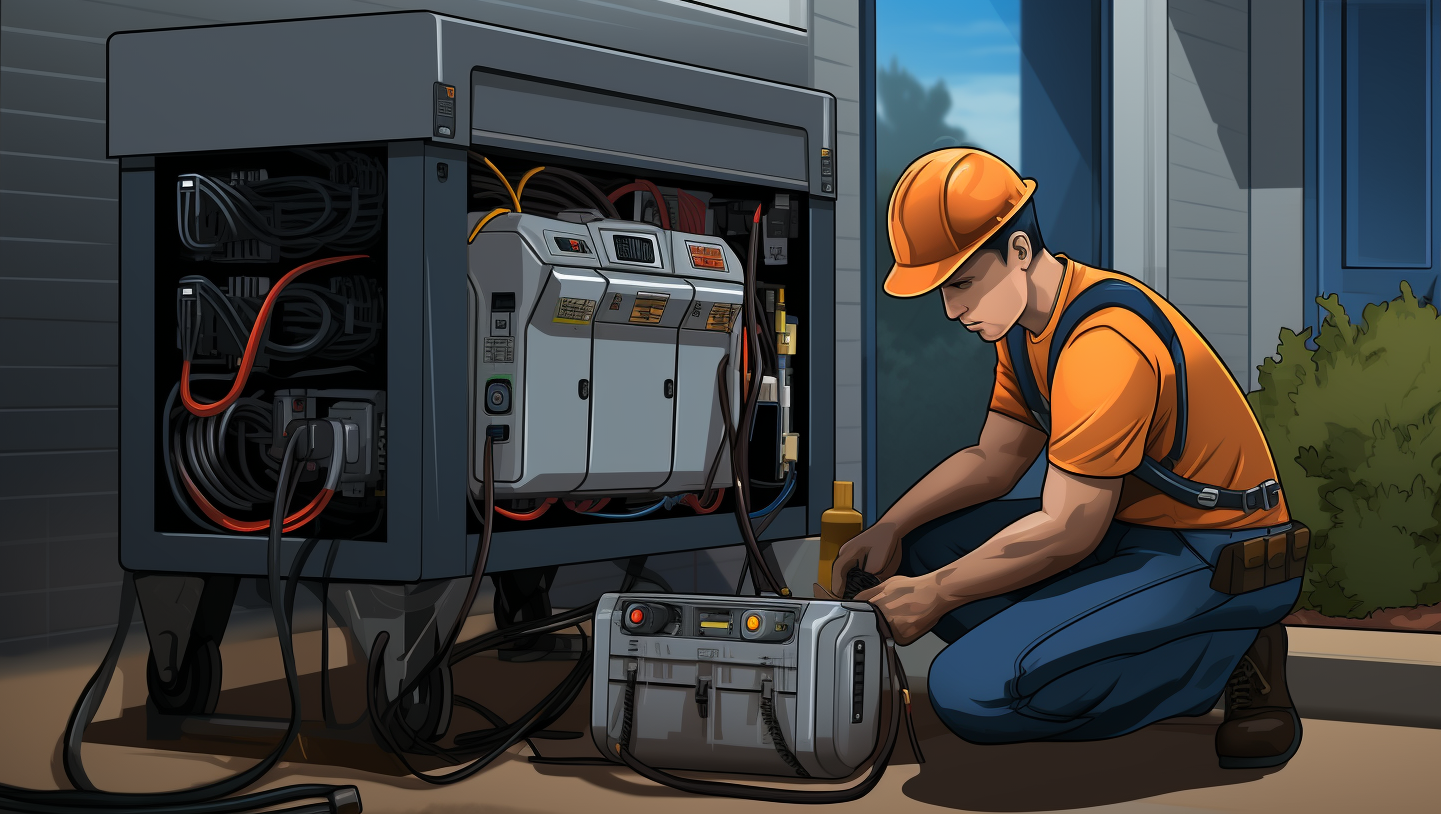Are you ready to power up and stay safe? In this article, our expert shares essential generator safety tips to keep you protected while enjoying uninterrupted electricity. From preventing carbon monoxide poisoning to avoiding electrocution and fire hazards, we’ve got you covered.
Discover how to choose the right generator, properly fuel and maintain it, and mitigate electrical risks. With our comprehensive guidelines and reminders, you’ll learn how to place and ventilate your generator for optimal safety. Get ready to stay safe and powered up with our expert advice.
Key Takeaways
- Carbon monoxide from generators is colorless and odorless, so it is crucial to install battery-powered carbon monoxide alarms inside your home to detect it.
- Generators should never be used indoors or in partially enclosed spaces to avoid carbon monoxide build-up.
- Always connect the generator to appliances using heavy-duty extension cords and avoid connecting it directly to the home power supply to prevent electrocution or electric shock.
- Keep the generator outside and store fuel in safe containers away from living areas to minimize the risk of fire.
Carbon Monoxide Poisoning Awareness
Carbon monoxide from generators is colorless and odorless, making it impossible to detect without alarms. This silent killer can quickly build up in enclosed spaces, such as homes, garages, and crawl spaces, leading to carbon monoxide poisoning.
To ensure your safety and the safety of your loved ones, never use generators indoors or in partially enclosed spaces. Operating generators near open doors and windows or using fans will not prevent carbon monoxide buildup.
It is crucial to install battery-powered carbon monoxide alarms inside your home, following the manufacturer’s recommendations. Remember, carbon monoxide can be deadly for both humans and pets.
Preventing Electrocution and Electric Shock
To avoid the risk of electrocution or electric shock, make sure to connect your generator to appliances using heavy-duty extension cords. This will ensure a safe and reliable connection between the generator and your devices. Follow these guidelines to prevent any accidents or injuries:
- Use heavy-duty extension cords rated for the wattage of your generator.
- Inspect the extension cords for any damage or wear before connecting them.
- Make sure the extension cords are properly plugged into both the generator and the appliances.
- Avoid using multiple extension cords connected together, as this can increase the risk of electrical hazards.
- Keep the extension cords away from water, heat sources, and sharp objects to prevent damage.
By adhering to these safety measures, you can enjoy the benefits of your generator while minimizing the risk of electrocution or electric shock.
Fire Safety Measures
Always keep the generator outside and fuel it outdoors as well to prevent the risk of fire. This is crucial for your safety and the safety of your home. When operating a generator, it is important to follow fire safety measures to avoid any potential hazards. Here are some key tips to keep in mind:
| Fire Safety Measures |
|---|
| Store fuel in properly labeled, non-glass safety containers outside living areas. |
| Avoid storing fuel near fuel-burning appliances, such as gas stoves. |
| Turn off and let the generator cool down before refueling to prevent ignition of gasoline or other flammable liquids. |
Important Generator Safety Tips In General
Make sure you install carbon monoxide alarms according to the manufacturer’s recommendations to protect yourself and your loved ones from the dangers of carbon monoxide poisoning.
- Place battery-powered carbon monoxide alarms inside your home as instructed by the manufacturer.
- Carbon monoxide is colorless and odorless, making it undetectable without alarms.
- Generators should never be used indoors or in partially enclosed spaces like garages and crawl spaces.
- Operating generators near open doors, windows, or fans will not prevent carbon monoxide build-up.
- Remember that carbon monoxide can be deadly for both humans and pets.
Choosing the Right Generator
If you need help choosing the right generator, consult with a qualified vendor or electrician who can provide expert advice based on your specific needs. They will guide you in determining whether you require a permanently installed standby generator or a portable generator .
It is crucial to read and follow the manufacturer’s instructions before using the generator. For permanent installation, ensure that it has a transfer switch, which should be installed by a qualified electrician in compliance with local electrical codes. This will ensure safe operation and prevent any risks to utility workers or bypassing household circuit protection devices.
Generator Safety Tips: Best Operating Practices
When operating your generator, remember to keep it outdoors in a well-ventilated area to prevent carbon monoxide emissions. This is crucial for your safety and the safety of those around you. Here are five important tips to help you operate your generator safely:
- Use heavy-duty extension cords to connect appliances to the generator.
- Turn on the generator before plugging in appliances, and avoid overloading the unit.
- Only use the generator when necessary in wet or moist conditions, and protect it from water.
- Operate the generator outdoors in a well-ventilated area.
- Turn off and cool down the generator before refueling to prevent ignition of gasoline or other flammable liquids.
By following these guidelines, you can ensure that your generator operates safely and effectively, providing you with the power you need while minimizing any potential risks. Stay safe and enjoy the peace of mind that comes with proper generator operation.
Fueling and Maintenance Guidelines
Remember to turn off and let the generator cool down before refueling to prevent the ignition of flammable liquids. Fueling and maintaining your generator properly is crucial for safe operation. Here are some guidelines to follow:
| Fueling and Maintenance Guidelines |
|---|
| 1. Turn off the generator and allow it to cool before refueling. |
| 2. Use the recommended fuel type for your generator. |
| 3. Regularly check and maintain the generator according to the manufacturer’s instructions. |
| 4. Keep the generator clean and free from debris. |
Electrical Risks and Precautions
To reduce the risk of electrical hazards, make sure to operate your generator on a dry surface and keep your hands dry before touching it. Here are some important electrical risks and precautions to keep in mind:
- Avoid touching the generator while it is running to prevent burns.
- Keep children and pets away from portable generators.
- Be aware of the electrical risks associated with generators.
- Operate the generator on a dry surface and under an open, canopy-like structure.
- Ensure your hands are dry before touching the generator.
By following these precautions, you can minimize the risk of electrical accidents and ensure safe operation of your generator. Remember to always prioritize safety when using electrical equipment, and seek professional help if needed. Stay informed and take the necessary steps to protect yourself and your loved ones.
Safety Guidelines and Reminders
Now that you are aware of the electrical risks and precautions associated with generators, let’s discuss some safety guidelines and reminders to ensure your safety and the proper operation of your generator.
First, it is important to post safety guidelines and basic operating instructions in your home and near the generator. This will serve as a reminder for everyone in your household to follow the necessary precautions. Additionally, make sure you are familiar with the emergency shutdown procedures for the generator in case of any unforeseen incidents.
Having a fire extinguisher nearby is also crucial in case of emergencies. Regularly test the generator to ensure it is in proper working condition, and stay informed about generator safety and any updates or recalls from the manufacturer.
Generator Placement and Ventilation
Make sure you always use a generator outdoors and away from open doors and windows. This is crucial for your safety and the safety of those around you. Here are some important guidelines to keep in mind when it comes to generator placement and ventilation:
- Operate generators in well-ventilated areas to reduce the risk of carbon monoxide poisoning.
- Install carbon monoxide detectors throughout your home to detect any potential leaks.
- Position the generator at least 20 feet away from your house or building while it’s running.
- Direct the engine exhaust away from doors, windows, and air conditioner units to prevent carbon monoxide from entering your living space.
- Avoid operating the generator in wet or damp conditions to minimize the risk of electrical shock.
By following these guidelines, you can ensure that your generator operates safely and effectively, providing you with the power you need while minimizing any potential risks. Stay safe and powered up!
Additional Information Resources for Generator Safety Tips:
- Watch the generator safety tips video by the Centers for Disease Control and Prevention (CDC) and FEMA, which includes American Sign Language.
- Access information on how to use portable generators safely from the Occupational Safety and Health Administration.
- Learn more about carbon monoxide through the CDC’s video at https://cdc.gov/co or by calling 800-232-4636.
- Stay updated on Hurricane Ida and find relevant information at https://fema.gov/disaster/4611.
- Follow FEMA Region 6 on Twitter and like them on Facebook.
Frequently Asked Questions
What Are the Different Wattage Ranges Available for Generators and What Are Their Recommended Uses?
The different wattage ranges for generators are: up to 3,000 watts for basic inverter generators, up to 6,000 watts for powering multiple appliances simultaneously, and up to 10,000 watts for larger power requirements. Choose accordingly based on your needs.
What Are Some Safety Precautions to Take When Using a Generator in Bad Weather Conditions?
When using a generator in bad weather conditions, prioritize safety. Avoid using the generator in rain, snow, or wet conditions to reduce the risk of electrocution and explosions. Consider using a canopy for protection or wait for the weather to improve.
What Is the Purpose of a Transfer Switch and Why Is It Important to Use One When Connecting a Generator to a Home’s Wiring?
A transfer switch is essential when connecting a generator to your home’s wiring. It ensures safe operation by preventing back-feeding, which can be dangerous for utility workers. Follow manufacturer’s instructions and consult a professional for installation.
What Are the Recommended Fuel Safety Practices When Using a Generator?
When using a generator, it’s crucial to follow fuel safety practices. Remember to use the recommended fuel type, store it in approved containers in a well-ventilated area, and never refuel while the generator is running or hot. Stay safe and prevent accidents.
What Are Some Maintenance and Inspection Tasks That Should Be Regularly Performed on a Generator to Ensure Its Proper Functioning?
Regularly perform maintenance and inspections on your generator to ensure proper functioning. Follow the manufacturer’s instructions, check for damage or wear, clean and remove debris, and test periodically. Keep it in top shape for reliable power.
Conclusion
Dear reader, remember that generators are like the guardians of your power supply, ensuring your safety and comfort in times of need. Just like a vigilant knight protecting a kingdom, generators require proper care and attention to fulfill their duty.
By following the expert generator safety tips provided in this article, you can harness the power of generators while keeping the dangers at bay. So, stay safe and powered up, knowing that your generator is your loyal ally in the face of any power outage or emergency.




